Explore the latest news and find out what's on this month
Explore our learning offer for schools, families and community groups
Uncover the rich history of Elmbridge with our latest online exhibitions
Want to discover more about your local area?
Explore the latest news and find out what's on this month
Explore our learning offer for schools, families and community groups
Uncover the rich history of Elmbridge with our latest online exhibitions
Want to discover more about your local area?
The historic sport of horseracing not only holds a unique place in British culture, but in the story of Elmbridge in particular. Since the opening of Sandown and Hurst Park in 1875 and 1890 respectively, this Great British pastime has been at the heart of Elmbridge’s identity.
Racecourses have often been scenes for both celebration and controversy. This Borough is no exception. As the home of two major racecourses, important tales of fame and conflict in Elmbridge’s history have been played out on their stages.
 'A Day at the Races' exhibition in the Dittons Library computer room.
'A Day at the Races' exhibition in the Dittons Library computer room.
This exhibition was on display in the main foyer at Elmbridge Xcel Leisure Complex from August 2021 to June 2022.
Want to take a closer look at the wonderful array of items – from horse skulls to Victorian riding boots – on display?
Look below to discover a selection of the stories and historic objects from Hurst Park and Sandown which were featured in the exhibition. Beginning with their origins at the Starting Line, we track their stories over challenging Hurdles, and through to the Home Straight and Finishing Line in the modern day.
To gain some expert insight into Elmbridge’s racing history, we talked to horseracing historian Stewart Nash. Stewart has previously given lectures at Molesey Local History Society and is author of ‘Plumpton: An illustrated history of Plumpton Racecourse, 1884-2000’. Discover the interview as short ‘Ask the Expert’ videos in each section!
Competitive horseracing began in the 1600s during the reign of James I, who established the tradition at Newmarket. But it was in the 1700s that horseracing really took off. Queen Anne was a huge fan of the sport, establishing the Royal Ascot. On the founding of the Jockey Club in 1750, the ‘Rules of Racing’ were systematically enforced at competitions across the country. Yearly meetings at Hampton Racecourse – the site which would later become Hurst Park – were recorded as early as 1814.
In this video, we look at the beginnings of horseracing at Sandown and Hurst Park Racecourses, and the early development of the sport in general. Click the play button to play the video.
 Print from original watercolour of horse and jockey entitled "Into the First Turn", by John Skeaping
Print from original watercolour of horse and jockey entitled "Into the First Turn", by John Skeaping
The wooden toy below bucks the trend of the other souvenirs of its day by portraying a standing horse.
Depictions of horses in motion, like the print (left) were far more common. John Skeaping worked in the early to mid 1900s, sculpting animals for Wedgewood as well as painting them.
The growing fashion for horseracing memorabilia cemented the sport’s place in British culture by capturing popular imagination.
Drag the page or click ‘next’ and ‘previous’ to flick through the pages.
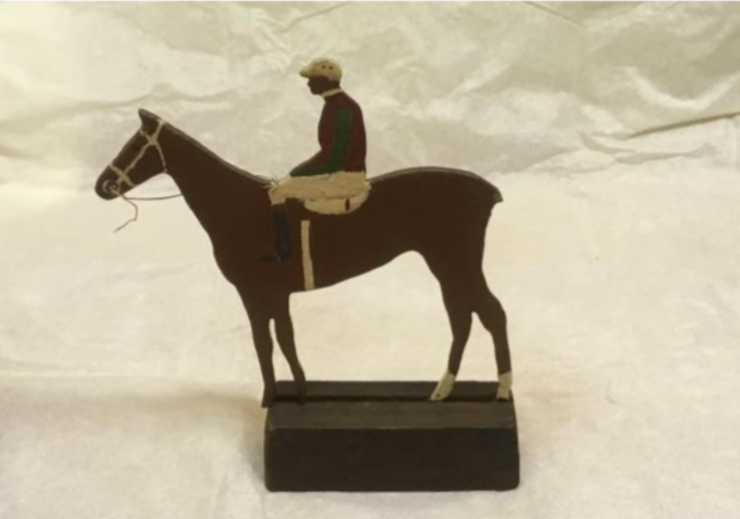
Mounted wooden horse and jockey toy.
As the Surrey Comet reports, it was in this environment of ‘bustle and excitement’ that Elmbridge’s racecourses opened their doors, demonstrated by the ‘Oatlands Racecard’ in Elmbridge Museum’s collection. Dating from 1826, it is one of the earliest examples we have of horseracing in the borough.
By 1875, Sandown Park had opened its doors to an enthusiastic public, and just 15 years later, in 1890, Hurst Park came into existence.
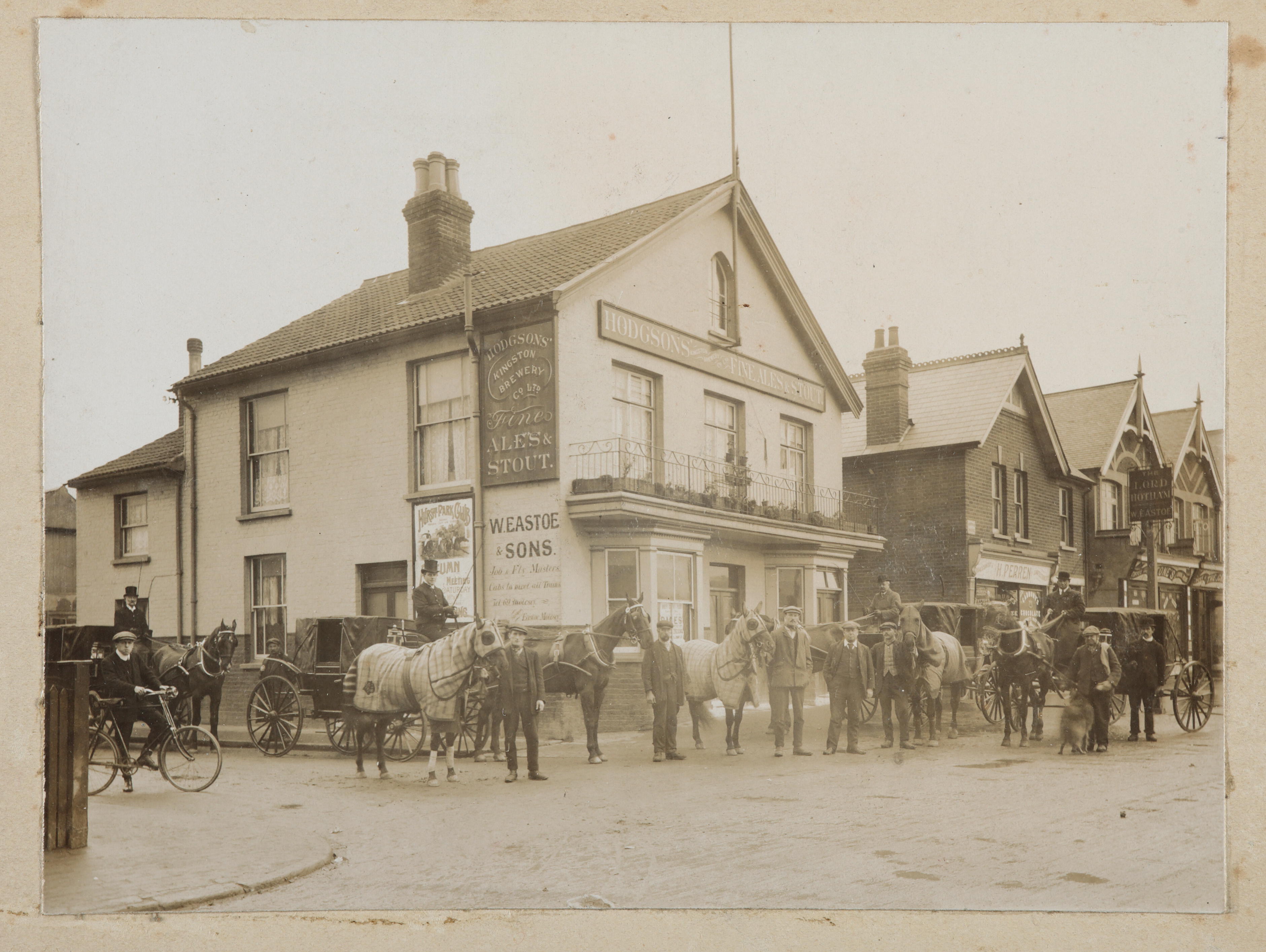
Photograph of an advert for a Hurst Park meeting at the Lord Hotham pub, 1910.
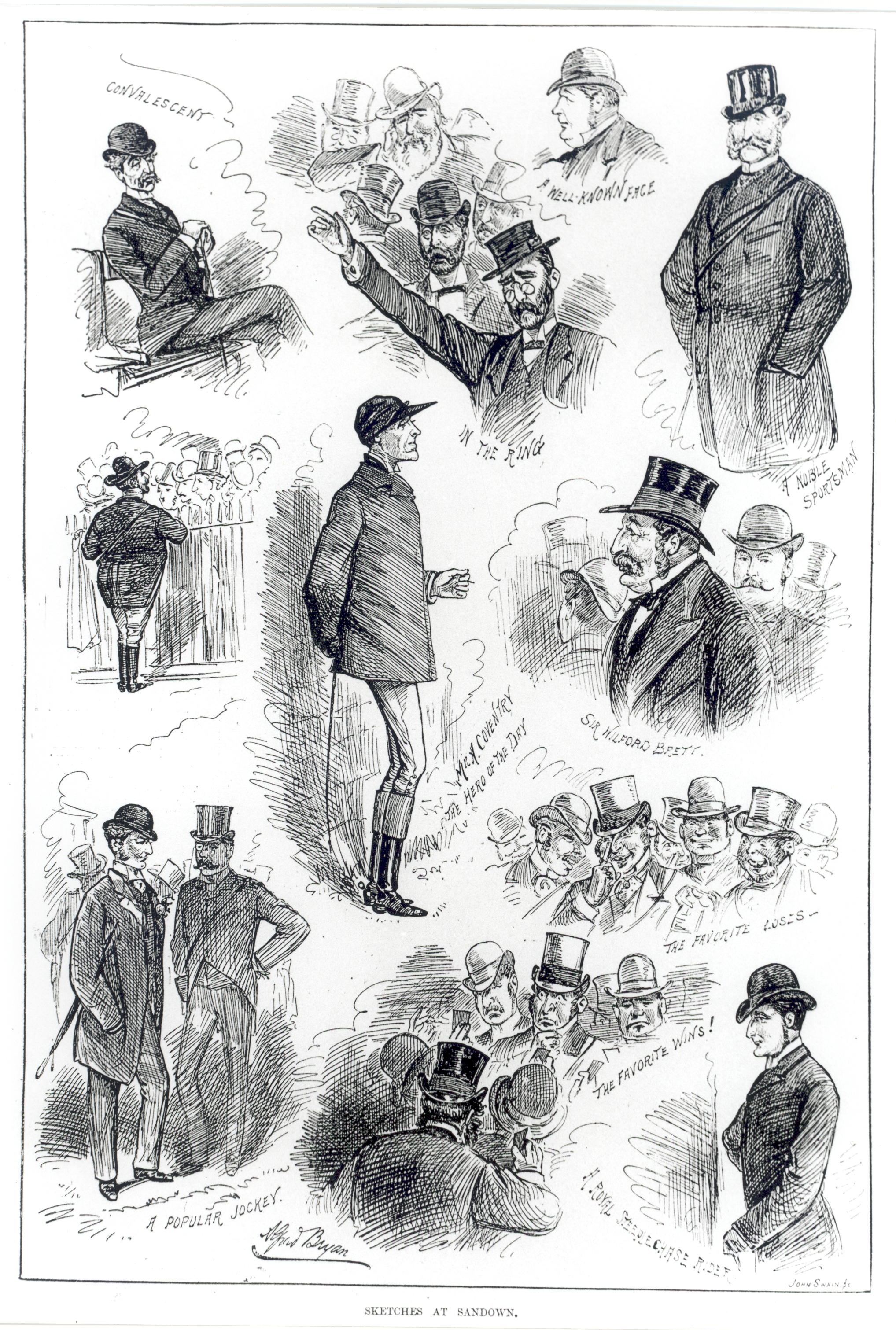 Engraving of men at Sandown, c. 1890s.
Engraving of men at Sandown, c. 1890s.  Photo of crowds in the Grandstand at the Sandown races, 1890s.
Photo of crowds in the Grandstand at the Sandown races, 1890s.
Racing was still an exclusive activity. Sandown’s perimeter was fully enclosed by a fence, allowing organisers to keep lower class ‘undesirables’ out by charging high entry fees.
Likewise, the Hurst Park Club Syndicate which had been formed prior to the construction of the racecourse were all exceedingly wealthy, prominent gentlemen in the late 19th Century world. These elaborate club badges and photo of affluent crowds demonstrate the selective audience of Victorian horseracing.

Five Hurst Park Club badges, 1911.
Sandown was the first racecourse to have a private members’ enclosure.
One warm summer night in June 1913, Elmbridge’s sky was lit up with flames. Hurst Park had become the latest victim in Britain’s developing conflict surrounding women’s suffrage. Suffragette violence was not the only challenge – Hurst Park had already made losses of roughly £2,300 before expanding to include flat racing in 1891.
In this second video in the series, we ask historian Stewart Nash about some of the challenges faced by horseracing at Sandown and Hurst Park Racecourses throughout their history, including the effects of the First and Second World Wars; Suffragette militancy and the struggle for gender equality in racing.
Click the play button to play the video.

The remains of Hurst Park Grandstand after Suffragette arson, June 1913.
The 1913 fire at Hurst Park formed part of a string of similar Suffragette attacks at venues across the UK, in their campaign for the female vote. Harold Hewitt ran in front of horses at Ascot brandishing a pistol a matter of weeks later and, most tragically, Emily Davison had died the day before the Hurst Park fire after trying to pin a Suffragette flag to the leading horse at the Epsom Derby.
Females were blocked from purchasing membership to the Hurst Park club at this time, just as they were largely excluded from the wider horseracing sphere. This, along with the Suffragettes’ desire to avenge Emily Davison’s death, may have been part of the reason that Hurst Park was targeted.
Along with accomplice Clara Giveen, experienced arsonist and radical Suffragette Kitty Marion was convicted of setting fire to the grandstand. Just 23 years after opening, Hurst Park had narrowly escaped ruin.
Eclipse was one of the earliest celebrity horses. He rocketed to notoriety in 1770 after winning 18 races in just 17 months, with records testifying that he could cover 25 metres a second.
This jawbone also gives an idea of the scale of Eclipse, every inch of which was examined by experts keen to discover the secret to his success.
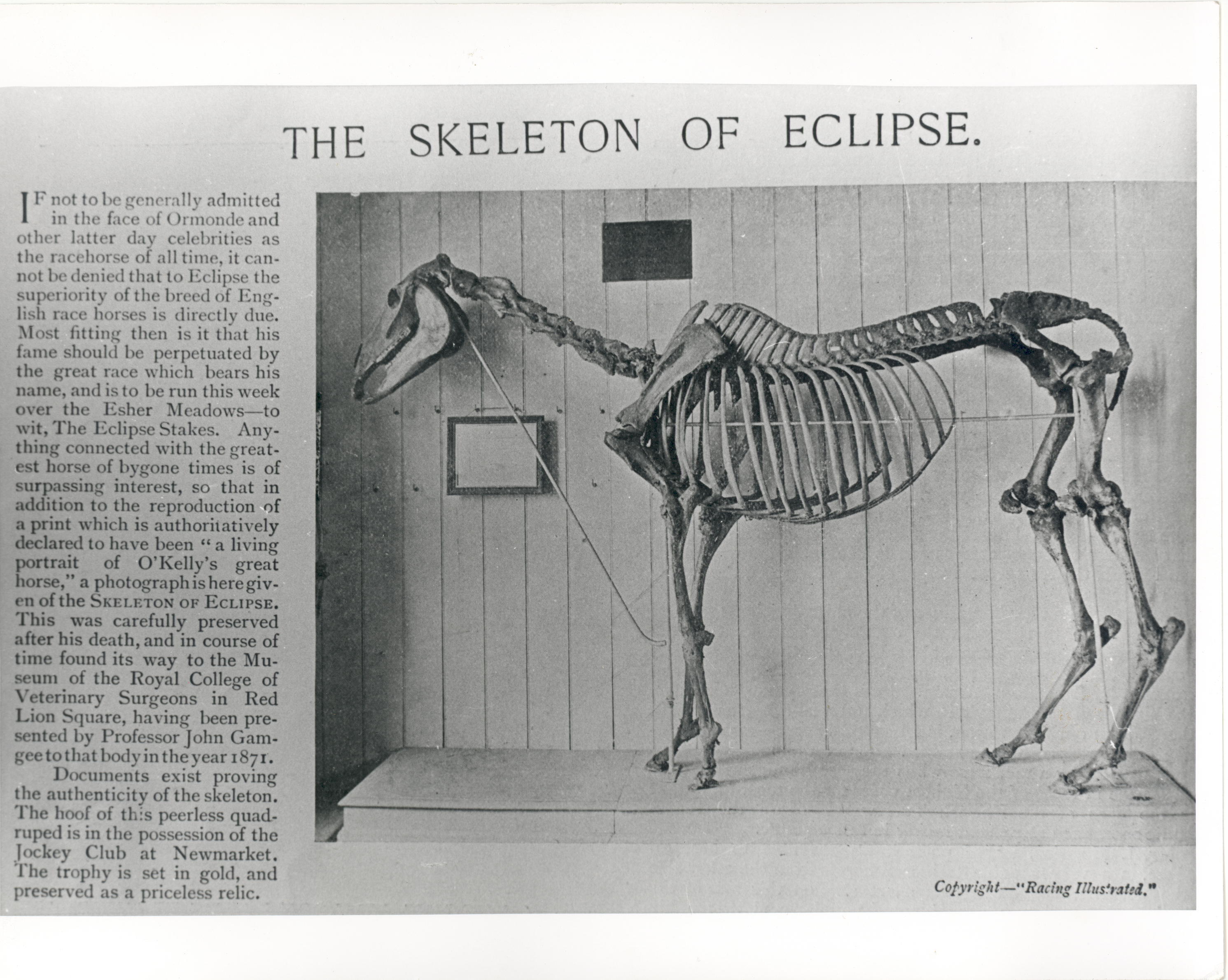
Copy of an article about “The skeleton of Eclipse”, c.1790.
This article demonstrates the relic status of Eclipse’s remains after his death in 1789.
The Eclipse Stakes at Sandown Park was famously named in the star’s honour, and it is thought that 95% of thoroughbreds are descended from Eclipse, with many of his relatives seeing success racing in Elmbridge.
“It cannot be denied that to Eclipse the superiority of the breed of English race horses is directly due. Most fitting then is it that his fame should be perpetuated by the great race which bears his name, and is to be run this week over the Esher Meadows – to wit, The Eclipse Stakes.”
The Jockey Club only began granting women licences as trainers in 1966.
As the 20th Century went on, the exclusivity which had made racecourses a target for protest gradually disappeared. Although still expensive, the popular pastime gradually became more inclusive with the introduction of female memberships to the Hurst Park club in the 1930s. For both racecourses, the late 1900s would bring widespread press – and would end with one even shutting its doors for good.
In our final video, we talk to historian Stewart Nash about the most recent years of horseracing at Sandown and Hurst Park Racecourses, including their post-war recovery, famous Royal visitors, some personal memories, and the reasons for Hurst Park’s eventual closure.
Click the play button to play the video.
Both racecourses survived a 1930s decline. At this time, brown riding boots became more common than traditional black due to a reduction in formal racing.
These brown leather riding boots with canvas leg covers belonged to the vet and jockey Boyce Barrow (1847-1939).
As previously outlined, both courses were involved in the Second World War, with the Royal Engineers mobilising at Hurst Park and the Welsh Guards based at Sandown.
Yet despite enduring and surviving a second war, Hurst Park finally closed in October 1962 after being sold to property developers.
Drag the page or click ‘next’ and ‘previous’ to flick through the pages.
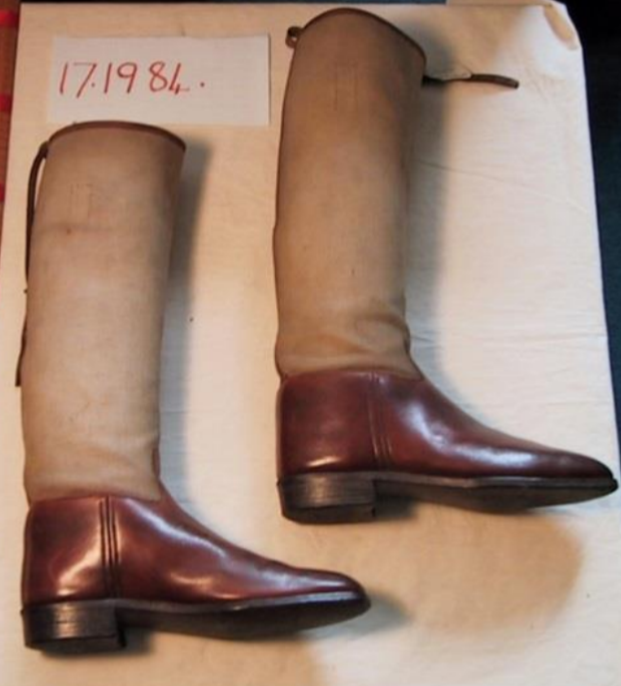 Brown leather riding boots with canvas leg covers which belonged to the vet and jockey Boyce Barrow (1847-1939).
Brown leather riding boots with canvas leg covers which belonged to the vet and jockey Boyce Barrow (1847-1939).  Sandown's Coral Eclipse Stakes Racecard, 8th July 1978 (left) and Sandown's Trafalgar's Day Racecard, 17th June 1978 (right).
Sandown's Coral Eclipse Stakes Racecard, 8th July 1978 (left) and Sandown's Trafalgar's Day Racecard, 17th June 1978 (right).
Unlike its unlucky neighbour, Sandown continued to thrive. After a huge refurbishment in 1972, the racecourse celebrated its centenary with a series of races in 1975. It continues to prosper as a venue for horseracing, concerts, and many other large events today.
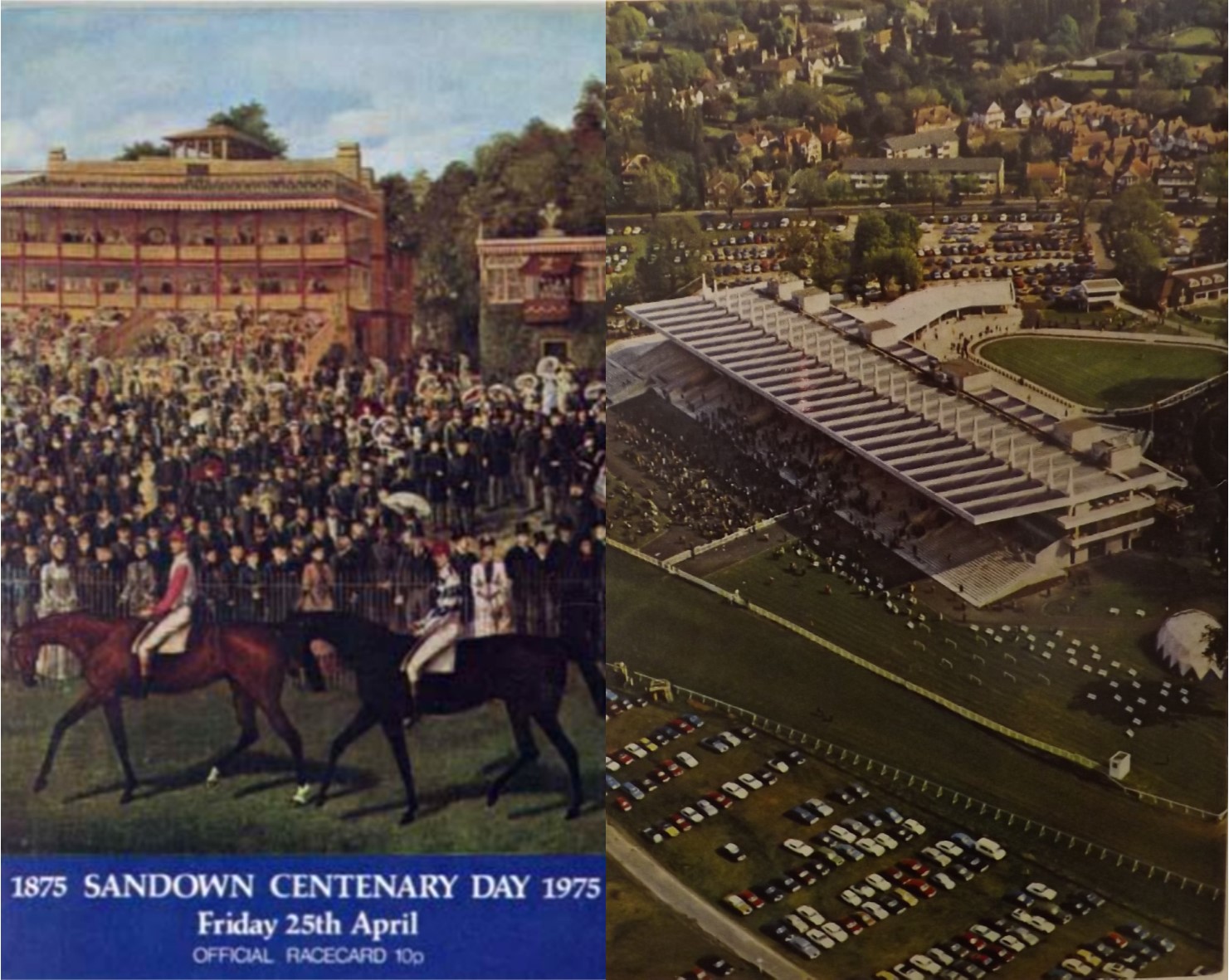
Sandown centenary day racecard, 1975, front cover (left) and back cover (right).
In 1947, Sandown became widely known as the first racecourse to have a race shown live on television.
Black and white photograph of Floods
at Hurst Park Racecourse, Hurst Park,
c.1904.
A race in progress at Hurst Park
Racecourse (c. 1950s).
Black and white photograph of two
jockeys jumping a fence on Hurst
Park Racecourse (c. 1950s).
Hurst Park Racecourse with race in
progress. Site of Graburn Way.
Undated (c. early 1960s).
Black and white photograph of the former
Esher Surveyor, Mr. Alderton, on extreme
right, with the Inspector presiding over Town
Planning Enquiry next to him and Mr. E.C.
Trotman, the donor, shown walking the Hurst
Park race course (c.1950s-60s).
Black and white photograph of the former
Esher Surveyor, Mr. Alderton (extreme
right) with the Inspector presiding over Town
Planning Enquiry next to him and Mr. E.C.
Trotman, the donor, in the middle. Two
other men, not named, are behind them
in the spectator stand at Hurst Park
Racecourse (c.1950s-60s).
Black and white photograph copy of
the engraving ''The Grand International
Steeplechase at Sandown Park'' (01/05/1880).
Black and white photograph copy of
the engraving ''Sketches at Sandown
Park Races''. p.109 (30/07/1881).
Black and white photograph copy of
the engraving ''Sandown Park Grand
Military Steeplechases on Saturday
Last'' taken from the Illustrated
London News (11/03/1882).
Black and white photograph copy of
the engraving ''Sandown Park Grand
Military Steeplechases on Saturday
Last'' taken from the Illustrated
London News (11/03/1882).
Black and white photograph copy of the
engraving ''Sketches at Sandown''
taken from The Illustrated Sporting &
Dramatic News (16/09/1882).
''A Busy Corner at Sandown'', copied
from 'Racing Illustrated' (05/08/1896).
Black and white photograph of 'The
Michaelmas Stakes' at Sandown Park
(16/09/1896).
The old Royal Box at Sandown Park
(pre-1945).
Black and white postcard of Sandown
Racecourse, Esher. It shows part of the
course with the grandstand full of people
in the background. Race in progress, three
horses in view (c. late 1950s -60s).
Black and white photograph of the Esher
Village Pump, which used to lie at the
boundary of Sandown Park but is now on
Esher Green (c. 1960). It is inscribed "This
pump has been erected by the inhabitants
of Esher from the donation presented to
their village by H.R.H the Comte De Paris
on his marriage with H.R.H the Infanta
Marie Isabelle of Spain, 30 May 1864.
Traveller drink and be grateful".
The Royal Box at Sandown Park (c.1960s).
A woman cleaning the scales upon the
reopening of Sandown Park, after it was
closed in November 1967 due to an
outbreak of foot and mouth disease
(05/01/1968).
A man sweeping up leaves in the
grounds for the re-opening of
Sandown (05/01/1968).
Two men putting up one of the 'jumps'
on the course at Sandown
(05/01/1968).
The Betting Board at Sandown Park
Race Course (05/01/1968).
The stables and yard at Sandown Park,
taken from above the grounds (c. 1970s).
Sandown Park buildings (1972).
Sandown Park buildings (1972).
The re-building of the Sandown Park,
Esher (c. 1972-3).
View of part of a horse race in progress
at Sandown Park Race Course on
corner nearest station (February 1987).
View of Sandown Park Race Course
showing mainly the grandstand
with ski-slope hill behind and to
the right. Taken on a race day from
Esher Railway Station platform
(February 1987).
Can you find the ten horseracing-related words in this word-search?
Interested in finding out more about Hurst Park, Sandown, and the history of Elmbridge? Take a look at some of these fascinating further resources, which explore themes and topics covered in this online exhibition in more detail.
Leave a Comment
Do you have your own memories of Sandown or Hurst Park? Leave your thoughts in the comment section here!You need to be logged in to comment.
Go to login / register